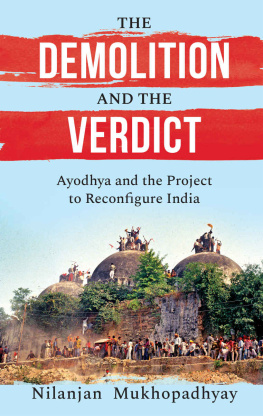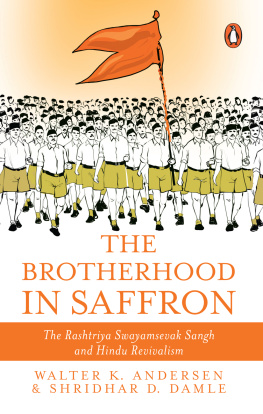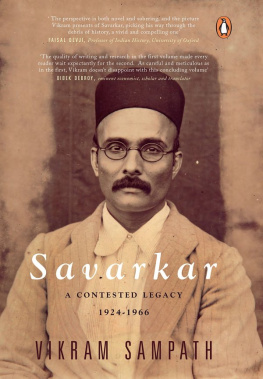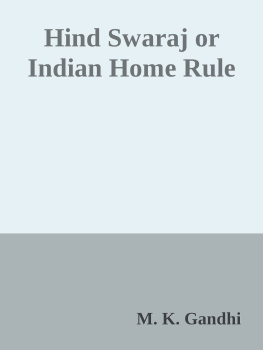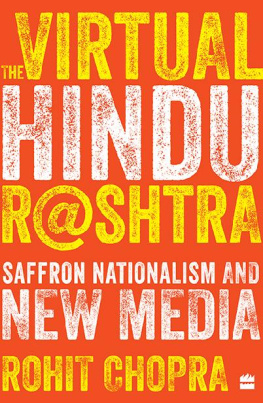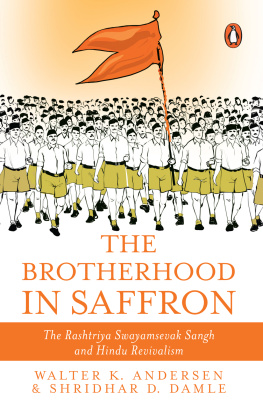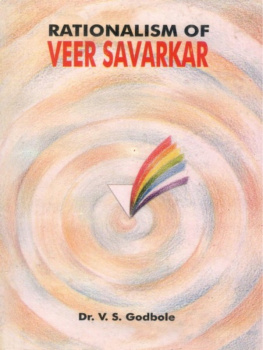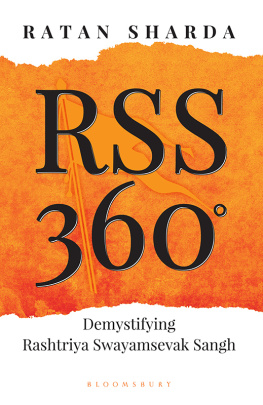
By the Same Author
Narendra Modi: The Man, The Times
Sikhs: The Untold Agony of 1984

First published in Tranquebar by Westland Publications Private Limited 2019
61, 2nd Floor, Silverline Building, Alapakkam Main Road, Maduravoyal, Chennai 600095
Westland, the Westland logo, Tranquebar and the Tranquebar logo are the trademarks of Westland Publications Private Limited, or its affiliates.
Copyright Nilanjan Mukhopadhyay, 2019
ISBN: 9789387894914
The views and opinions expressed in this work are the authors own and the facts are as reported by him, and the publisher is in no way liable for the same.
All rights reserved
No part of this book may be reproduced, or stored in a retrieval system, or transmitted in any form or by any means, electronic, mechanical, photocopying, recording, or otherwise, without express written permission of the publisher.
For Varsha
Often the peg where I hang my stuff.
CONTENTS
AUTHORS NOTE
T his book defines itself. The Indian Right-wing understandably evokes extreme reactions. This is especially true of the Rashtriya Swayamsevak Sangh (RSS), its affiliates and individuals who have at various times influenced its thought processes and actions. I was drawn to its workings from the early 1980s, thanks to encouragement from my editors who gave me the opportunity to report and analyse several episodes involving communal conflict. Later, many proceeded to indulge me in what they defined as my growing obsession with the Ayodhya dispute.
Often their point being, and this group gradually included many politicians and several close friends, about my interest in subjects involving sectarian violence. There was of course scepticism about my premise and many arguments would be put forth about the inherent secular character of Indians. I was told ad nauseam that this was a transitory phase in the history of Indian politics and that the sangh parivar constituents had peaked a little too early.
Yet, my apprehensions rang true even as India was overwhelmed by several episodes, including the Babri demolition case in 1992, and the Gujarat riots almost a decade later. Even on the eve of the 2019 elections, my concern is that whichever way the final verdict goes, it will not alter the trajectory the country is already on.
One of the most difficult things about writing on this subject was to fundamentally disagree with the premise of Hindu nationalism, yet apply reason while analysing it and its iconic leaders. Over the years, considerable literature has been added to what was previously available. In my view, most of them continue to exist in black or white, either as hagiographies or denunciations. This book not only endeavours to examine the ideologies of Right-wing leaders, but also explores the personas behind the personalities.
I am sure my readers will have several complaints, foremost being that many who may have played decisive roles in bringing the Indian Right-wing to the forefront are either absent in this book, or even if present, then not in the manner many may have imagined them to be. The initial idea of limiting these portraits to mere thumbnails, did not do justice to any of the personalities listed in the book. The worry at times was that each personality included in this edition necessitated a separate book and which may turn out to be more than one. With time, and further expansion of the Indian Right-wing, and with due indulgence from my family, readers and publishers, it may be worth its while to return to the theme, but let me not worry about it at this stage.
For a variety of reasons, this book has been a long time in the making. A significant part of its form, content and style has altered over the years, save a major part of the title. Relief often becomes the overarching emotion at the end of a creative exercise and it is no different for me.
It was Gyanesh Kudaisya who had first suggested that I write this book. This was way back in 19992000 when Atal Bihari Vajpayee was Indias prime minister and the Rashtriya Swayamsevak Sangh and its affiliates had suddenly sprung from near obscurity to centre stage. I had even written a few chapters, but made no headway as professional engagements took me on to another path. Yet, he prodded me continuously, particularly after the 2014 elections, never once giving up hope in my ability, and patiently pointing out what was lacking after he had read one of the chapters. I hope he notices that his suggestions were taken seriously.
No words shall suffice in thanking Dilip Deodhar who held my hand and guided me through what I think is an extremely complicated world inhabited by the sangh parivar. He was aware of my basic disagreement with its ideological premise, but he never shied away from sharing information, often enlightening me, besides lavishing praise for my sense of what he thought was, fairness. Dilip Deodhar introduced me to several members of the Right-wing whose identities must remain secret, for many continue to be in the RSS.
Thanks are also due to Sanjeev Kelkar for sharing his insights and understanding of the RSS, its weaknesses and strengths.
A major part of this book was written during a professionally trying period and my family stood like a rock behind me to lighten the burden. It remains a joke amongst them that restraint is not one of my virtues, but they also acknowledge that the courage to be truthful never weakened. Over the years, Gyan Vermas understanding of the Right-wing has sharpened considerably, and every conversation with him helps me to reconsider various premises. Varsha remains my first reader and critic, who constantly debated with me and enabled me to sharpen certain arguments which helped me to recast some of my views. It shall still be several years before my granddaughters understand what I write, but now they grumble less for the time not spent with them.
This has been my third book with Sudha Sadhanand as editor and we have developed a capacity to be patient with each other. Often, it was her enthusiasm for the book which prevented me from becoming cynical. I hope that her passion for the book is shared by my readers.
I would also like to thank the several books and pamphlets and other materials that I read and re-read which helped my narrative immensely.
A last word of gratitude for Sanjay Malapur who approached me in 2018 during the Bangalore Literature Festival with a request to take my pictures. I asked him if he could also take some for this book. He agreed and did a splendid job knowing well there was no other reward than seeing the photograph in print. May success come in abundance to him.
Nilanjan Mukhopadhyay
New Delhi, February 2019
KESHAV BALIRAM HEDGEWAR
I n the history of the Rashtriya Swayamsevak Sangh (RSS), which is known for the domineering presence of Konkanastha or Chitpavan Brahmins, it is probably one of the biggest quirks of fate that its founder was born into a family of migrants from a village in Telangana.
In the early decades of the nineteenth century, several landless Brahmin families who made their living as priests in Nizamabad district, were forced to flee their homes under the Mughal rule. Many chose to settle in Nagpur, a city which was ruled by Maratha Bhonsle kings, mainly because the dispensation supported Vedic learning. Keshav Baliram Hedgewars great-great-grandfather was among those who had made the city his home. Gradually, these immigrant families from Andhra Pradesh began to assimilate, and not only did they adapt to Maharashtrian customs, but also began looking up to local historical icons as their very own.
Next page

